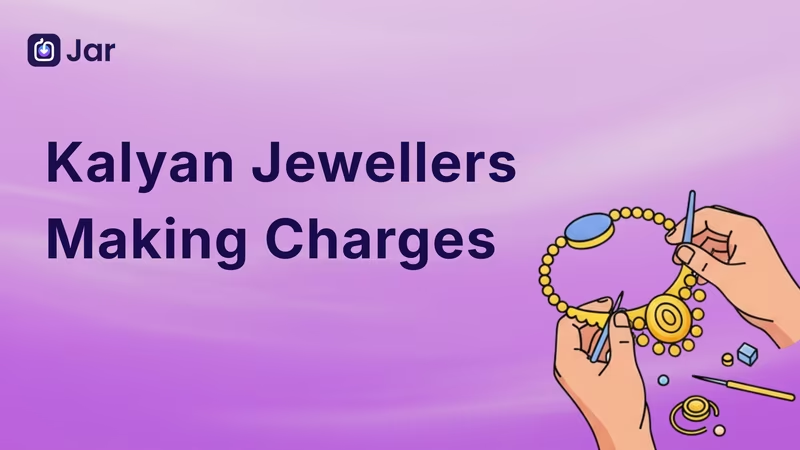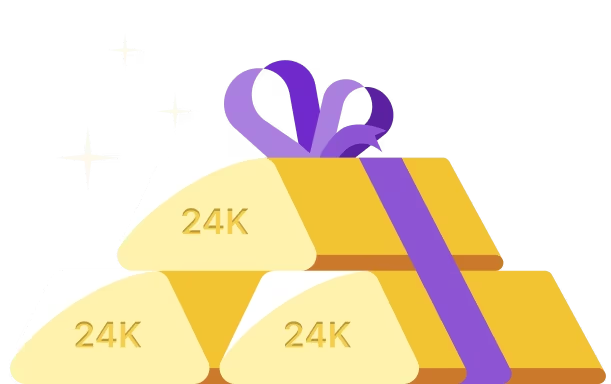You love the beautiful designs at Kalyan Jewellers, but you need a clear answer to one question: How much do the production costs cost, and how can you plan for them?
You've looked up everything from the total cost of making Kalyan jewellery to the cost of making gold in Kalyan jewelry per gram.
We understand! Finding out what the final price of gold is can be hard.
Let's open the bill together and show you how to shop for gold at Kalyan Jewellers in a smart way.
Unpacking Kalyan Jewellers' Making Charges
The term "making charge" is the most crucial part of your gold bill after the metal cost itself. It’s the fee for craftsmanship, the true cost of turning raw gold into wearable art.
Why Do Jewellers Charge a Fee?
This fee exists because of the labor involved. When you pay the making charges at Kalyan Jewellers, you are covering:
- The Artisan's Skill: The time and expertise of the goldsmith.
- Technology & Overheads: The cost of specialized cutting, shaping, and polishing machines, plus showroom running costs.
- Design & Quality Assurance: Ensuring the jewellery is finished to Kalyan's renowned quality standards.
The Typical Percentage Range Of Making Charges
The total gold making charges at Kalyan Jewellers are not fixed. They are dynamic and based on the piece. However, generally speaking, you can expect the charges to fall into a wide bracket:
- Overall Range: Typically starts low (around 5% for simple items like gold coins) and can go up to 40% for highly intricate, handcrafted jewellery.
Making Charge vs. Wastage Charge (Simplified)
While many jewellers used to list these separately, they are closely linked:
- Making Charge: The fee for the labor and skill.
- Wastage Charge: A charge to cover the tiny bits of gold that are inevitably lost (as dust or shavings) during the cutting, shaping, and polishing process.
Many modern, large retailers, including Kalyan Jewellers, often roll the wastage cost into the total making charge for a simpler, single-line item on your bill. Always clarify this with your salesperson!
Get a simple breakdown of the customs duty structure and learn how to calculate your total cost before importing gold.
The Art of Calculation: How Your Bill is Created
The process of making charges starts the moment a piece is designed. Kalyan Jewellers applies these charges using two main formulas, depending on the complexity of the piece.
Percentage of Value (The Common Method)
This is the most frequent way the Kalyan Jewellers charges on gold are calculated. The charge is set as a percentage of the total gold value in the item.
This method makes sense for complex, high-effort designs because as the design effort increases, the percentage goes up.
- Example: A simple chain valued at ₹1,00,000 might have a 19% making charge (₹19,000), while a designer necklace could have a 35% charge (₹35,000).
Fixed Rate Per Gram (The Simpler Method)
For standard, high-volume items, or simple gold investment products like coins, the charge might be a fixed rupee amount for every gram of gold.
This answers the query about Kalyan Jewellers making charges per gram.
- Logic: Since the labor for machine-made chains or simple coins is consistent, charging, say, ₹500 or ₹700 per gram provides a clear, transparent cost to the buyer, regardless of daily gold price fluctuation.
What is the process of setting the charge?
The charge is set by a matrix that prioritizes:
1. Design Complexity (Filigree work, Kundan setting, etc.),
2. Metal Purity (18K, 22K, etc., which affects how easy it is to work with).
3. Labor Time (handcrafted vs. machine-made). The more hands-on time a piece requires, the higher the final making charge of gold in Kalyan Jewellers will be.
Understand how the 2025 budget could impact gold and jewellery prices so you can plan your purchases wisely.
Making Charges for Different Categories
To help you budget before you even step into the store, here are the general ranges for Kalyan Jewellers making charges across major jewellery categories.
Remember, these are typical ranges and can vary based on the specific collection (Nimah, Mudhra, etc.).
Simple & Machine-Made Items (Coins, Basic Chains)
Items that require less manual intervention and are often created using automated processes naturally have the lowest fees.
- Typical Percentage: 5% to 25%
- Examples: Plain gold chains (non-designer), gold coins, simple machine-stamped lockets.
Medium Complexity Pieces (Rings, Pendants, Studs)
These pieces involve a mix of machine work and manual finishing or designs that require multiple small components to be soldered together.
- Typical Percentage: 7% to 32%
- Examples: daily-wear rings, simple pendants, and earrings.
Highly Intricate & Handcrafted Jewellery (Bangles, Bridal)
This category covers high-skill designs like heavy bridal sets, Kundan work, or temple jewellery (often part of their Nimah or Mudhra collections). The Kalyan making charges here reflect master craftsmanship.
- Typical Percentage: 28% to 40%
- Examples: bridal bangles, heavy necklaces, Mangalsutras, and custom-designed pieces.
Learn the simple way to understand making charges so you know exactly what you’re paying for when buying gold.
Tips to Save on Your Purchase Of Gold
Knowing the calculation methods is only half the battle. As an informed customer, you have ways to lower your final bill and minimize the burden of Kalyan Jewellers making charges on gold.
1. The Festive Flat Discount (The Seasonal Offer)
This is the most straightforward and popular type of offer, often seen around major festivals like Diwali, Akshaya Tritiya, Onam, or Christmas/New Year.
- A flat discount applied directly to the making charge percentage. You see an immediate reduction on the final bill.
- "Up to 50% Off on Making Charges" or "Flat 25% Off Making Charges on Gold Jewellery." Crucially, these discounts often apply to all jewellery except for plain gold coins/bars, making it perfect for buying ornaments.
2. The Gold Saving Scheme Benefit (The Systematic Offer)
Kalyan Jewellers has structured savings plans like the Dhan Samriddhi Scheme and the Purchase Advance Scheme. While the main goal is systematic saving and price protection, they often include a huge discount on the final making charge as a bonus.
- At the time of redemption (when the scheme matures after 6 or 11 months), the accumulated benefit may include a significant waiver on the making charges.
- In some older schemes, this waiver was as high as 18% to 21% of the making charges, sometimes resulting in near-zero making charges for select items. The benefit effectively covers a significant portion of the labour cost.
- This benefit is an incentive for you to save with them and commit to buying from their store, providing them with interest-free capital.
3. The Diamond/Studded Jewellery Discount (The Cross-Category Offer)
While this doesn't directly reduce the gold making charge, it's a critical financial benefit they often provide, especially through their savings schemes, that offers huge savings on the overall final bill.
- Schemes like Dhan Samriddhi often offer an alternative benefit: a fixed, substantial discount on studded jewellery.
- You can get up to 7% to 9% off the total cost of diamond or studded jewellery. Since the 'value additions' (which include both making charges and the cost of stones) are very high on diamond jewellery, this percentage discount translates to a huge cash saving on the final price.
Understanding the Final Price Formula (GST Inclusion)
To avoid sticker shock at the counter, always factor in the final tax. The making charges Kalyan Jewellers are included in the taxable value.
- The Rule: There is a flat 3% GST on the total cost of the jewelry, which includes the gold price and the cost of making it. You won't be surprised if you know this!
Get a clear breakdown of how Tanishq prices its gold rings and coins so you can make smarter, transparent purchases.
You now know the secret to Kalyan Jewellers' gold prices you know the small difference between the two main ways to calculate prices and why the making charge for a simple chain is very different from that of a heavy bridal necklace.
The making charge is what art really costs. You can be sure you're getting a fair price for the work you get by knowing that the average price range is 5% to 40% and looking for holiday sales.
Feel free to shop with confidence. Knowing things is powerful, and in this case, it might save you a lot of money!










